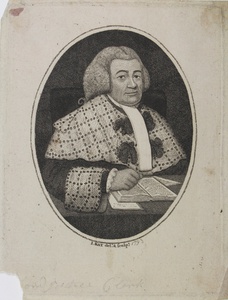| Method | Etching and stipple |
| Artist | John Kay |
| Published | [John Kay, 1793] |
| Dimensions | Image 100 x 76 mm oval, Plate 133 x 98 mm, Sheet 138 x 106 mm |
| Notes |
A half-length portrait of Robert MacQueen, seated at a table, turned slightly to right, wearing robes with ermine collar and cuffs, ribbons, bands, and a wig, his right hand resting on an open book on the table, in an oval. 'I. Kay delt & Sculpt. 1793' inscribed below the image. Lifetime impression. Robert McQueen, Lord Braxfield (1722 - 1799) was a Scottish advocate and judge, responsible for the invention of the crime of unconscious sedition. John Kay (1742-1826) was a Scottish miniature painter, satirist, and engraver, chiefly celebrated for his caricatures of many of the most notable Scotsmen of his day. Born in Dalkieth, the son of a Mason, he was orphaned at a young age, and following an unhappy childhood with his mother's relatives in Leith, he was apprenticed to the barber, George Heriot. After six years working under Heriot in Dalkieth, he moved as a journeyman barber to Edinburgh. In 1771, he joined the Corporation of Barber Surgeons, gained the freedom of the city, and set up his own barbershop. Despite having no formal training in, and no great talent for, the finer points of artistic pursuits, he pursued his drawing with dedication. Kay's quick hand and canny wit made him a natural satirist, and the remarkable likenesses of his earlier portraits to their real world counterparts began to be noticed by his customers. The most important of these was William Nisbet of Dirleton, who would eventually become his patron. Nisbet's death in 1784 brought Kay a small annuity, which enabled him to give up his barbershop, and focus his full attentions on his art. From a small shop in Parliament Close, Edinburgh, Kay issued his portraits. Redgrave attributes to Kay almost nine hundred plates, which constitute an unparalleled chronicle of Edinburgh life at the turn of the eighteenth and nineteenth centuries. Kay's portraits, though objectively of only slim artistic merit, are warm, lively, and in some cases, bitingly clever. His talent for provoking his subjects was famous, leading on one occasion to a failed prosecution, and on another to an apparent cudgeling. Despite this, Kay's star continued to rise. In 1811 and 1816, his work was exhibited by the Edinburgh Associated Artists, and in 1822, he contributed to the Institution for the Encouragement of the Fine Arts in Scotland. As early as 1792, he had planned to release a collection of his works in book form, along with a short biographical sketch that supplies almost all of the known details of his life, but the project remained unrealized at his death. It was not until 1837, almost a decade after his death, that a collection of 340 of his plates were first published. Ex. Col.: Hon. Christopher Lennox-Boyd Condition: Some surface dirt to edges, stain upper left, crease lower right corner, loss to paper into plate but not affecting image lower left, manuscript note in pencil identifying sitter along bottom. |
| Framing | mounted |
| Price | £45.00 |
| Stock ID | 42584 |

